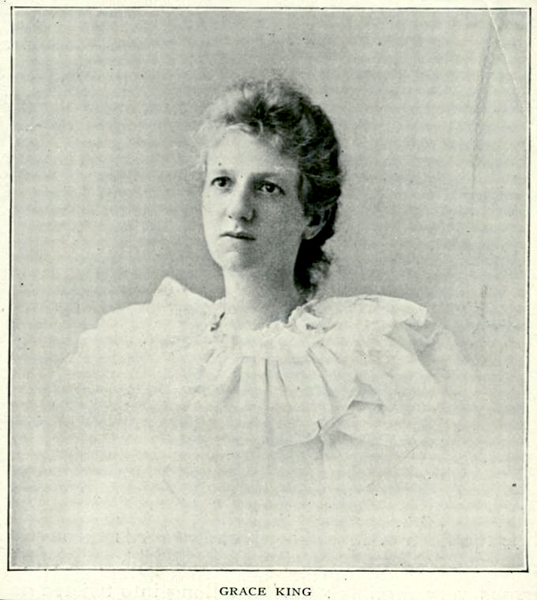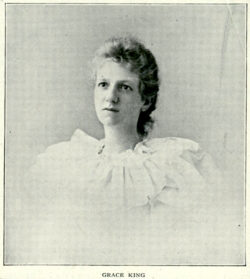Local Color Fiction
Local color fiction was a literature genre popular with American readers between 1870 and 1900.

Courtesy of New York Public Library
Grace King. Unidentified
Louisiana writers played an important role in the development of local color fiction, a type of literature popular with American readers between roughly 1870 and 1900. Local color fiction typically forefronts the distinctive dialect, history, and customs of a specific place or region. Often featuring locales outside mainstream American culture, local color introduced the nation’s readers to a variety of little-known regions. Bret Harte, famous for his stories of the American West, is generally thought to be the first American local color writer, but Louisiana authors, including George Washington Cable, Kate Chopin, and Ruth McEnery Stuart, soon became central figures in the genre.
Louisiana’s diversity and unique cultural communities offered writers plenty of material for inspiration. Beginning with the 1873 publication of George Washington Cable’s story “‘Sieur George” in Scribner’s Monthly, the state became a familiar setting for local color fiction. Authors published stories about Louisiana in such national publications as Harper’s Monthly, New Princeton Review, and Lippincott’s. Often, they used the popular short story format to explain Louisiana’s racial hierarchy and ethnic diversity to a national audience generally unfamiliar with the state’s unique cultural heritage. Local color fiction about southern locales proved particularly popular in the late nineteenth century. With the end of the Civil War and Reconstruction, northern audiences seemed particularly receptive to information about their former foe. In response, Louisiana local colorists—like other southern writers—sometimes used their work to celebrate, justify, or explain their region’s past.
George Washington Cable
George Washington Cable, for example, chose the local color genre to critique Louisiana’s racial history. Where other southern writers chose to defend the southern plantation system and its reliance on slavery, Cable criticized racism in New Orleans and insisted on the region’s biracial heritage. Following the South’s defeat, the meaning of the term “Creole” was in flux in Louisiana. White aristocrats, anxious to defend their social status, insisted that the term applied only to whites of European descent, even though historically it had applied to French-speaking African Americans as well. In his 1880 novel, The Grandissimes, Cable argued against this exclusive definition by describing the region’s history of miscegenation and the racially mixed population that had resulted. Cable’s other fictional works, including Old Creole Days (1879) and Madame Delphine (1881), also present race relations from a postbellum, liberal perspective. In such stories as “Madame Delphine” and “‘Tite Poulette,” Cable explores the subject of racial passing—fair-skinned blacks “passing” for white—thereby subverting the idea of racial “purity” among Louisiana Creoles.
“‘Tite Poulette” also examined white Creole fears concerning the decline of French culture after the Louisiana Purchase and the subsequent growth of American government. Departing from the New Orleans setting, Bonaventure, published in 1888, offers a different perspective on Louisiana’s Acadian population than Longfellow’s popular Evangeline (1847). In all of these stories, Cable argues for American progress and against such institutions as segregation—an institution that, in Cable’s mind, prevented Louisiana Creoles from breaking with archaic traditions.
Grace King
Cable’s definition of Creole and interpretation of Louisiana history angered and inspired local historians and authors to take up the pen in defense. Grace King was one such writer. Like Cable, King wrote about miscegenation, but in her 1893 story “The Little Convent Girl,” miscegenation is linked with tragedy. A girl chooses suicide rather than living as a mixed-race woman in Louisiana, suggesting the undesirable consequences of miscegenation. Drawing on her personal experiences, King’s fiction captures not only the postbellum world of Louisiana, but also the particular world of women and their relationships with each other. Published in 1888, Monsieur Motte tells the story of the orphan Marie Modeste, a young white woman attending boarding school in New Orleans, and Marcelite, her devoted black servant, typical of a character popular in southern local color fiction attempting to justify the past. King’s stories capture local customs and speech, but also broader issues concerning the place of women in American society and the nature of race relations in the South.
Kate Chopin
Like Grace King, Kate Chopin explores complex gender and racial issues with characters as diverse as the state itself. Originally from St. Louis, Missouri, Chopin moved to Louisiana after marrying Oscar Chopin in 1870. Though Chopin returned to St. Louis two years after her husband passed away, her fiction frequently features characters and places from Louisiana. Chopin’s well-known novel, The Awakening (1899), for instance, depicts the protagonist’s personal awakening, especially regarding sexuality, in Louisiana. Though Chopin’s representation of women’s internal life and inclusion of a birthing scene garnered much criticism when the novel was first released, late-twentieth-century scholars made the novel central to feminist studies in American literature.
Because it acknowledges the diversity of the state, Chopin’s first collection of short stories, Bayou Folk (1894), offers readers a unique perspective on Louisiana’s ethnic and race relations. In the story “Désirée’s Baby,” for example, Chopin tells a story of miscegenation with a famous ironic ending, questioning racial and gender assumptions of the tragic mulatto tradition. Similarly, in “La Belle Zoraïde,” she critiques the state’s complicated racial hierarchy by showing the title character’s heartbreak. The collection also contains tales about Louisiana’s Acadian or Cajun population: “At the ‘Cadian Ball” and “A Gentleman of Bayou Têche.” Her second short story collection, A Night in Acadie, published in 1897, continues to explore Louisiana and its unique cultural communities, including, in “Ozème’s Holiday,” the mixed-race community of Cane River Creoles living in Isle Brevelle.
Ruth McEnery Stuart
Born in Marksville, Ruth McEnery Stuart moved with her family to New Orleans, where she lived until marriage took her to Arkansas. Following her husband’s death, Stuart returned to New Orleans, where she supported herself through her writing, later moving to New York to pursue additional literary success. The New Princeton Review published “Uncle Mingo’s Speculations,” her first story, in 1888. Like Chopin, Stuart wrote about a diverse array of women. The story “Queen o’ Sheba’s Triumph” featured an African American woman, while “The Woman’s Exchange of Simpkinsville,” a story in A Golden Wedding and Other Tales (1893), focuses on rural women in a fictional Arkansas town. Her fiction captures the world of Louisiana plantations and of African American dialects and diversity as well, as in Napoleon Jackson, the Gentleman of the Plush Rocker (1902) and in “Christmas Gifts,” published in A Golden Wedding and Other Tales. Criticized for its sentimental and sometimes stereotypical portrayals of women and African Americans, Stuart’s work felt into disrepute among many twentieth-century literary scholars. Studying her female protagonists, however, recent feminist critics have reconsidered Stuart’s work within the context of women’s regional writing.
Local Color’s Impact
Lafcadio Hearn and Alice Dunbar-Nelson also made vital contributions to Louisiana local color literature. Hearn lived in New Orleans for ten years, during which he collected Creole stories and songs, many published in Gombo Zhèbes, Little Dictionary of Creole Proverbs in Six Dialects (1885). A native of New Orleans and part of the black Creole community, Alice Dunbar-Nelson presents another version of Louisiana Creoles in her collections,Violets and Other Tales (1895) and The Goodness of St. Rocque and Other Stories(1899). Even after the turn of the century, Louisiana authors continued to capture particular regions of the state in their fictional work. Such writers as Ada Jack Carver, Lyle Saxon, Roark Bradford, Elma Godchaux, Shirley Ann Grau, and Ernest Gaines, among others, reflected and perpetuated the interest in Louisiana’s unique and eclectic population.
In addition, scholarly interpretations of local color fiction have shifted over the years, especially in terms of gender and race studies. Local color fiction has been, justifiably, criticized for its superficial depiction of cultures and racist portrayals of black characters. In recent years, however, scholars have suggested that the genre presents more complex renderings of race and gender than previously imagined. In local color writing, these scholars argue, women writers in particular found a forum to explore everyday life, including themes and situations familiar to them. For this reason, the fiction of local colorists like Grace King, Kate Chopin, and Ruth McEnery Stuart has become more central to the study of Louisiana literature.
